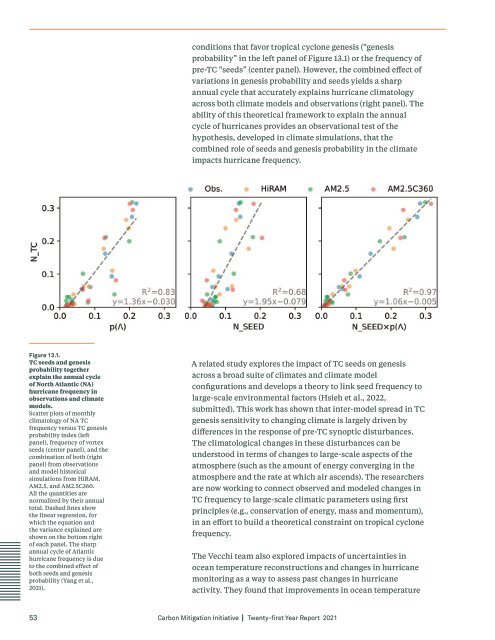CMI Annual Report 2021
Create successful ePaper yourself
Turn your PDF publications into a flip-book with our unique Google optimized e-Paper software.
conditions that favor tropical cyclone genesis (“genesis<br />
probability” in the left panel of Figure 13.1) or the frequency of<br />
pre-TC “seeds” (center panel). However, the combined effect of<br />
variations in genesis probability and seeds yields a sharp<br />
annual cycle that accurately explains hurricane climatology<br />
across both climate models and observations (right panel). The<br />
ability of this theoretical framework to explain the annual<br />
cycle of hurricanes provides an observational test of the<br />
hypothesis, developed in climate simulations, that the<br />
combined role of seeds and genesis probability in the climate<br />
impacts hurricane frequency.<br />
Figure 13.1.<br />
TC seeds and genesis<br />
probability together<br />
explain the annual cycle<br />
of North Atlantic (NA)<br />
hurricane frequency in<br />
observations and climate<br />
models.<br />
Scatter plots of monthly<br />
climatology of NA TC<br />
frequency versus TC genesis<br />
probability index (left<br />
panel), frequency of vortex<br />
seeds (center panel), and the<br />
combination of both (right<br />
panel) from observations<br />
and model historical<br />
simulations from HiRAM,<br />
AM2.5, and AM2.5C360.<br />
All the quantities are<br />
normalized by their annual<br />
total. Dashed lines show<br />
the linear regression, for<br />
which the equation and<br />
the variance explained are<br />
shown on the bottom right<br />
of each panel. The sharp<br />
annual cycle of Atlantic<br />
hurricane frequency is due<br />
to the combined effect of<br />
both seeds and genesis<br />
probability (Yang et al.,<br />
<strong>2021</strong>).<br />
A related study explores the impact of TC seeds on genesis<br />
across a broad suite of climates and climate model<br />
configurations and develops a theory to link seed frequency to<br />
large-scale environmental factors (Hsieh et al., 2022,<br />
submitted). This work has shown that inter-model spread in TC<br />
genesis sensitivity to changing climate is largely driven by<br />
differences in the response of pre-TC synoptic disturbances.<br />
The climatological changes in these disturbances can be<br />
understood in terms of changes to large-scale aspects of the<br />
atmosphere (such as the amount of energy converging in the<br />
atmosphere and the rate at which air ascends). The researchers<br />
are now working to connect observed and modeled changes in<br />
TC frequency to large-scale climatic parameters using first<br />
principles (e.g., conservation of energy, mass and momentum),<br />
in an effort to build a theoretical constraint on tropical cyclone<br />
frequency.<br />
The Vecchi team also explored impacts of uncertainties in<br />
ocean temperature reconstructions and changes in hurricane<br />
monitoring as a way to assess past changes in hurricane<br />
activity. They found that improvements in ocean temperature<br />
53<br />
Carbon Mitigation Initiative Twenty-first Year <strong>Report</strong> <strong>2021</strong>
















